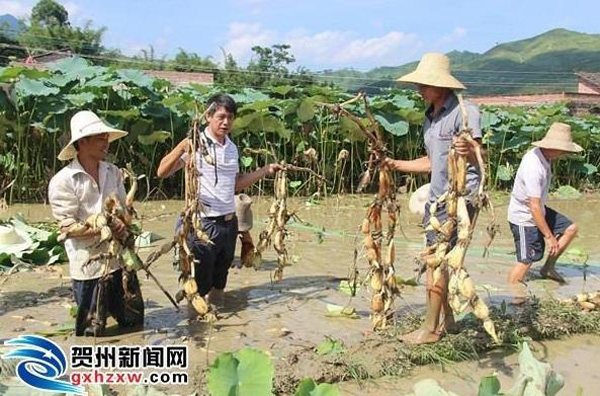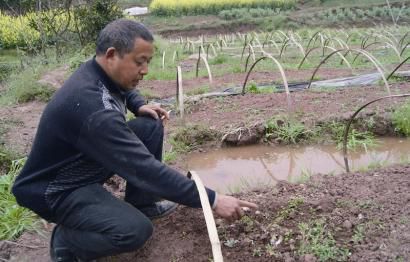Xie Qingmian, a big lotus seed farmer: "One water for two purposes", fish breeding lotus double harvest

Xie Qingmian (second from left) is digging lotus roots.
Now in rural areas, many people choose to go out to work to earn money to support their families. However, after going out for a while, many people take a fancy to the good development future of their hometown and choose to return to their hometown to develop the breeding industry. In Xinxin Village, Gonghui Town, Pinggui Management District, there is such a farmer who returned to his hometown to plant lotus root and set up a farmers' cooperative. His name is Xie Qingmian. Recently, the reporter walked into Xinxin Village, Gonghui Town, Pinggui Management District, and saw this tall lotus root man and listened to him talk about his experience of growing lotus root in his hometown.
The lotus root: dry as soon as you say it
"A man who had never planted a field went home to plant lotus root." In early 2010, the news that Xie Qingmian had returned home to plant lotus roots spread in the village. At first, no one could believe it. Like many farmers, Xie Qingmian has the experience of going out to work. He has successively worked in Guangdong, Fujian and other places, done wholesale sales of vegetables and native products. Xie Qingmian opened his eyes after visiting a 600-mu lotus root planting base in Quanzhou, Fujian Province, by chance in 2009. "at that time, looking at the endless lotus root fields, more than 100 lotus root diggers inserted a high-pressure water nozzle into the mud and pulled up the sturdy lotus roots in less than a minute. And I heard that this Fujian merchant earns several million yuan a year by growing lotus root alone. " Seeing the development of lotus root industry in Hubei, Fujian and other places, lotus root not only has a high output and good price, but also sells well in domestic and foreign markets. Compared with his hometown, due to the backwardness of planting technology and other reasons, the output and quality of lotus root have not been improved, and the market has not responded well. Xie Qingmian, who has always wanted to go home and start a business, suddenly came up with an idea that he should also introduce foreign varieties and technology, go back to his hometown to start a business, develop lotus root cultivation, and lead the villagers to become rich.
In the second half of 2009, Xie Qingmian had an in-depth exchange with his cousin Xie Qingrang, who worked as a branch secretary in his hometown, with his idea of growing lotus roots on a large scale. Subsequently, Xie Qingmian successively went to Jinan City, Shandong Province, Wuhan City, Hubei Province, and other places to conduct market research, "worship teachers and learn skills" from local big lotus root growers to learn their techniques and experience in large-scale cultivation of lotus root, and made a special trip to the Hubei Aquatic vegetable Research Center to learn and consult experts in the study of aquatic vegetables, and conducted a comprehensive study and understanding of key technologies such as lotus root seedling cultivation, fertilization, management, mining, and so on.
Just after the Spring Festival in 2010, Xie Qingmian selected a new variety of lotus root that can be planted for two seasons a year from the Hubei Aquatic vegetable Research Center according to the climate and soil conditions of his hometown, and rented 30 mu of paddy fields in the village for trial planting. Xie Qingmian's new variety of lotus root has a yield of more than 5000 jin per mu in the first season. Except that the yield per mu is 1/3 higher than that of the traditional lotus root, the appearance, taste and powder of the lotus root are better than those of the traditional lotus root. The lotus root is sold on the market for 5 yuan per kilogram, and the price is 50 to 80 cents higher than the traditional lotus root. Excluding the cost, the annual income of lotus root per mu is more than 20,000 yuan.
"the key to planting lotus roots is variety and digging. The traditional method of picking and digging lotus roots can dig up to 100 jin a day, so there is no way to plant lotus roots on a large scale." Xie Qingmian said that this year, he has expanded his lotus root planting area to 200 mu. Using the lotus root mining technology learned from other places, one person can dig more than 500 jin a day, greatly improving the efficiency of lotus root mining.
Grow lotus root and get rich: drive the villagers to get rich
No pains, no gains. Compared with traditional lotus roots grown in Hezhou, Xie Qingmian's lotus roots are not only high-yielding, but also more expensive than local traditional lotus roots, which makes Xie Qingmian taste the sweetness of growing lotus roots in his hometown. The new variety of lotus root rose to fame in Hezhou vegetable wholesale market, was welcomed by vegetable merchants and supermarkets everywhere, and became a hot product in the market, and it was ordered out as soon as it was listed.
As the benefits of planting lotus roots show, he has become rich. As a member of the Communist Party of China, Xie Qingmian does not just think about himself, but drives the villagers to start planting lotus roots. Farmers in Shatian Town, Shilong Town, Zhongshan County, and Shita Village, Liansheng Village, Tianfu Village, Yang Hui Village, New Countryside, and Limu Village around Xinxin Village have also come to learn his lotus root planting skills. And he also enthusiastically imparted experience and technical tracking to the villagers in all aspects from seedling raising, management to digging, and made use of his previous access to the vegetable business to help lotus root farmers sell lotus roots to Wuzhou, Yulin, Nanning, Guangdong, Hong Kong and Macao in Guangxi. It is reported that since he returned home in 2010 to plant lotus root, Xie Qingmian has driven farmers in surrounding villages and towns to plant more than 3000 mu of lotus root.
In order to better introduce and promote the good quality of lotus root, provide unified technical service guidance for lotus root farmers, carry out packaging and sales of lotus root, and establish a large-scale management channel running through planting, production and marketing for the lotus root planting industry. In 2011, Xie Qingmian also established a farmers' cooperative, a professional cooperative for leap soil cultivation, with nearly 200 members. Today, Xie Qingmian and his members have rented more than 500 mu of paddy fields in the flat area of Shita Village, and are ready to introduce high-yield Zizania latifolia, premature Zizania latifolia, horseshoe and other aquatic crops to plant them, constantly enriching the variety of products, and forming new and advantageous characteristics of modern lotus root and aquatic products interplanting and interplanting.
Dissatisfied with the current situation: "one water and two uses" fish culture and lotus root harvest
In order to improve efficiency, Xie Qingmian had a whim. He took advantage of the advantage of growing lotus roots to raise fish in lotus root fields. In order to increase the feasibility, Xie Qingmian successively went to Shandong, Jiangxi and other places to learn lessons. "this model of 'planting lotus root and raising fish' means that fish products such as Loach and crucian carp are raised in the paddy field, and the saprophytes produced by the lotus root are used as fish fodder. At the same time, the fish also provides fertilizer for the growth of the lotus root, which has better economic benefits."
Although Xie Qingmian knows that so far no one in Hezhou has adopted the mode of "planting lotus root and raising fish," he said that action should be taken. At the beginning of this year, Xie Qingmian invested more than 1.2 million yuan, rented 48 mu of land, and began an attempt to "grow lotus root and raise fish." It is reported that the output value of "planting lotus root and raising fish" can reach more than 20, 000 yuan per mu of double-season lotus root, together with the fish, the additional output value can be increased by about 5000 yuan per mu.
- Prev

Mulberry branches grow mushroom "waste wood" to make money
Mulberry branches grow mushroom "waste wood" to make money
- Next

College student village officials make gifts and grow small watermelons to find a way to get rich.
College student village officials make gifts and grow small watermelons to find a way to get rich.
Related
- A course of planting techniques and methods on how to grow carrots
- How to plant the latest tulips?
- Is it better to pick tea in the morning or in the afternoon? When is the best time for tea to be picked? what is the third or fifth tea?
- Launch Yuanxiao Happy combination Haocha + Tea Yuan healthy Taste
- Penghu Tourism "Fireworks 20 Parade with You"
- 2022 West Lake Happiness holds "Digital Revitalization Voucher" and draws iphone13 and laptop.
- Banqiao Fuzhou social houses are designed to change start-up combined with police elimination to create a safe and livable environment
- The convenient measure of "mechanical weeding" in Xinbei has been abused and the Agriculture Bureau has imposed heavy penalties on the illegal land consolidation.
- Changgeng University Joins Hands with Four Memory Factories to Rescue Memory Talent Shortage
- The list of Taiwan's top 100 MVP managers is listed by the Director-General of the Farmers' Association of Sanxia District.

